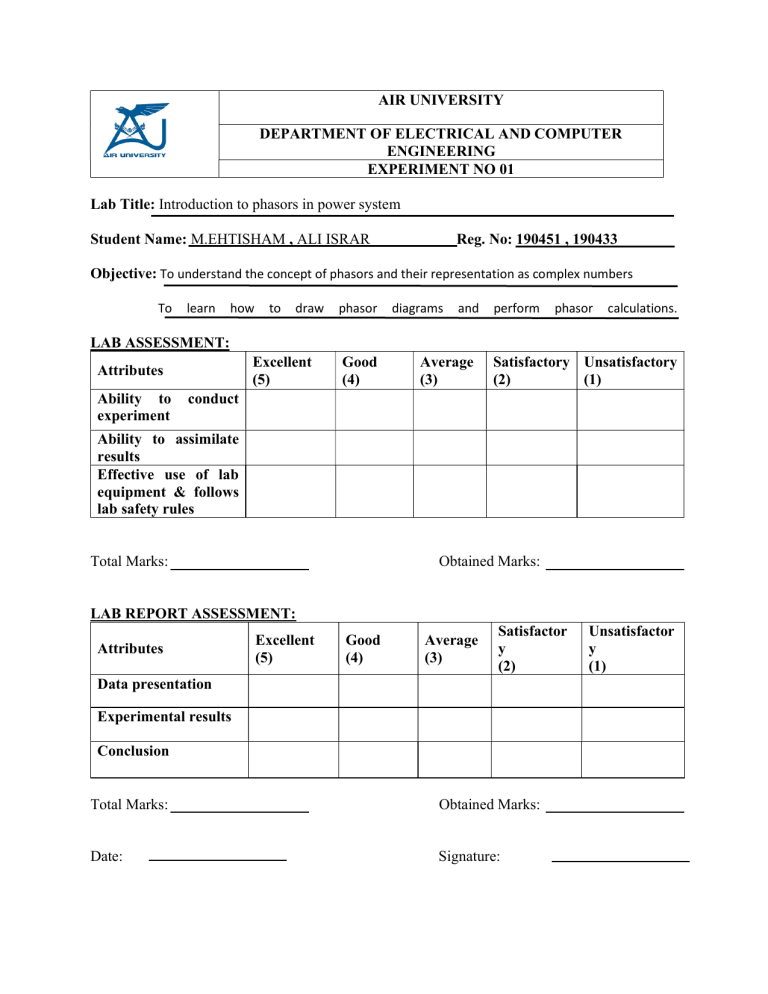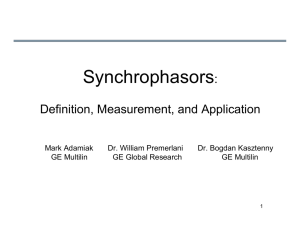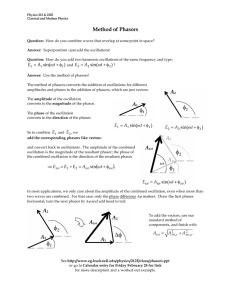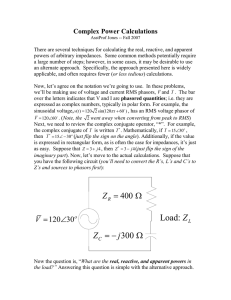
AIR UNIVERSITY DEPARTMENT OF ELECTRICAL AND COMPUTER ENGINEERING EXPERIMENT NO 01 Lab Title: Introduction to phasors in power system Student Name: M.EHTISHAM , ALI ISRAR Reg. No: 190451 , 190433 Objective: To understand the concept of phasors and their representation as complex numbers To learn how to draw phasor diagrams and perform phasor calculations. LAB ASSESSMENT: Excellent (5) Attributes Ability to experiment Good (4) Average (3) Satisfactory Unsatisfactory (2) (1) conduct Ability to assimilate results Effective use of lab equipment & follows lab safety rules Total Marks: Obtained Marks: LAB REPORT ASSESSMENT: Attributes Excellent (5) Good (4) Average (3) Satisfactor y (2) Data presentation Experimental results Conclusion Total Marks: Obtained Marks: Date: Signature: Unsatisfactor y (1) AIR UNIVERSITY DEPARTMENT OF ELECTRICAL AND COMPUTER ENGINEERING EXPERIMENT NO 01 Lab Title: Introduction to phasors in power system Student Name: M.Usama Liaqat , Ghulam Raza Reg. No: 190457 , 190441 Objective: To understand the concept of phasors and their representation as complex numbers To learn how to draw phasor diagrams and perform phasor calculations. LAB ASSESSMENT: Excellent (5) Attributes Ability to experiment Good (4) Average (3) Satisfactory Unsatisfactory (2) (1) conduct Ability to assimilate results Effective use of lab equipment & follows lab safety rules Total Marks: Obtained Marks: LAB REPORT ASSESSMENT: Attributes Excellent (5) Good (4) Average (3) Satisfactor y (2) Data presentation Experimental results Conclusion Total Marks: Obtained Marks: Date: Signature: Unsatisfactor y (1) Experiment 01 Introduction to phasors in power system Aim: The aim of this lab is to study the concept of phasors in power systems. Objective: To understand the concept of phasors and their representation as complex numbers. To learn how to draw phasor diagrams and perform phasor calculations. Discussion: Phasors are an important concept in power systems. They are used to represent the amplitude and phase of sinusoidal signals, such as voltages and currents in AC circuits. In a power system, phasors are used to analyze and solve problems related to power flow, voltage regulation, and fault analysis. A phasor is a complex number that represents a sinusoidal signal. It has a magnitude and an angle, which correspond to the amplitude and phase of the signal, respectively. The magnitude of a phasor is usually denoted by the absolute value or modulus symbol (| |), while the angle is denoted by the argument symbol (∠). Phasors can be represented graphically as vectors, with the magnitude as the length of the vector and the angle as the direction. Phasors are used in power systems to simplify the analysis of AC circuits. For example, in a power flow analysis, phasors are used to represent the voltage and current in each bus of the power system. This allows the analysis to be performed using complex numbers, which simplifies the calculations and reduces the number of equations that need to be solved. Phasors are also used in fault analysis to determine the location and type of faults in the power system. In this case, phasors are used to represent the voltage and current at different points in the power system. By analyzing the phasor diagrams, it is possible to determine the location of the fault and the type of fault, such as a short circuit or an open circuit. Procedure: Convert rectangular/ cartesian plane into polar and vice versa to solve a system. To convert rectangular planes into polar use the following command in MATLAB. A=2+3i [x1,y1]=cart2pol(real(A),imag (A)) x11=rad2deg(x1) To convert polar into rectangular planes, use the following command in MATLAB. mag=4 angle=30 angle=deg2rad(angle) [x1,y1]=pol2cart(angle, mag) A=x1+i*y1 Use subplot command to plot 𝑖(𝑡), 𝑣(𝑡) and 𝑝(𝑡) in one frame. To plot phasor diagram or to represent any vector quantity in MATLAB, use following commands: line ([0 real(A)], [0 imag(A)],'marker','>') text (1.05*real(A),1.05*imag(A),'A') Where 1.05 is a factor to place text in a suitable alignment and can be changed accordingly, line is used to draw a line including real and imaginary values, 'marker','>' is used for arrowhead to represent line as a vector. Lab tasks: Attach clear picture of MATLAB code and results for the following tasks: Task 01: Given the complex numbers A1, A2: A1= 5 ∠ 30 A2= -3+j4 a. b. c. d. e. Convert A1 to rectangular form. Convert A2 to polar and exponential form. Calculate A3= A1+A2, giving your answer in polar form. Calculate A4= A1×A2, giving your answer in rectangular form. Calculate A5= A1/A2*, giving your answer in exponential form. A) Convert A1 to rectangular form. Result: B) Convert A2 to polar and exponential form. Result: C) Calculate A3= A1+A2, giving your answer in polar form Result: D) Calculate A4= A1×A2, giving your answer in rectangular form. Result: E) Calculate A5= A1/A2*, giving your answer in exponential form. Result: Task 02: Figure 1 Figure 1 represents a supply voltage of 𝑣(𝑡) = 100𝑐𝑜𝑠𝜔𝑡 with load having impedance 𝑍 for: Inductive load 𝑍 = 1.25 ∠ 60 Capacitive load of 𝑍 = 2.0 ∠ − 30 Resistive load of 𝑍 = 2.5∠0 Using MATLAB, plot 𝑖(𝑡), 𝑣(𝑡) and 𝑝(𝑡) over an interval of 0 to 2π. Also estimate real and reactive power for each load. (Hint: use subplot command) Code: RESULTS: Task 03: Figure 2 Circuit presented in Figure 2 operates on 50 Hz frequency with 𝑣𝑟𝑚𝑠 = 24𝑉 whereas, R= 40 Ω, L=50mH. Using MATLAB. a. Find the 𝐼 , 𝐼 ,𝑉 and power factor cos ϕ. b. Display all the required values using display command. c. Plot the phasor diagram of voltages for R and L with required labeling. Code: RESULTS: Task 04: Figure 3 Circuit presented in Figure 2 operates on 50 Hz frequency with 𝑣𝑝(𝑡) = 100∠20 whereas, R=5 Ω, L=20mH and C=400µF. Using MATLAB a. Find the complex power S, the average power P, the reactive power Q and power factor cos ϕ. b. Display all the required values using display command. c. Plot the phasor diagram of voltages for R, L and C with required labeling. CODE: RESULT: Conclusion: This lab aimed to study phasors in power systems, with objectives to understand their concept and representation as complex numbers, as well as to learn how to draw phasor diagrams and perform calculations. Through this lab, we have gained a comprehensive understanding of phasors' significance in analyzing AC circuits and power systems. Also, we perform different MATLAB programs related to these topics. Phasors, represented as complex numbers, allow us to visualize and analyze the relationships between voltage, current, and power in sinusoidal waveforms. Drawing phasor diagrams aids in understanding the phase relationships between different quantities, while performing phasor calculations enables us to solve complex circuit problems and assess the effects of impedance and power factor. This lab has provided us with the necessary knowledge and skills to further explore and apply phasor analysis in electrical engineering.




